 Ever wondered how much it would cost to build a working, life-sized Gundam robot? At least $725 million for the parts and materials, according to an estimate published on the SciencePortal website run by the Japan Science and Technology Agency. The price tag for this giant humanoid, which would stand 18 meters (60 feet) tall and weigh 43.4 metric tons (nearly 100,000 lbs), does not include the cost of labor (this is where an extensive pool of robot slave labor comes in handy), nor does it include the cost of the infrastructure needed to support the machine once you are ready to climb aboard and take it for a walk.
Ever wondered how much it would cost to build a working, life-sized Gundam robot? At least $725 million for the parts and materials, according to an estimate published on the SciencePortal website run by the Japan Science and Technology Agency. The price tag for this giant humanoid, which would stand 18 meters (60 feet) tall and weigh 43.4 metric tons (nearly 100,000 lbs), does not include the cost of labor (this is where an extensive pool of robot slave labor comes in handy), nor does it include the cost of the infrastructure needed to support the machine once you are ready to climb aboard and take it for a walk.
Estimated cost of Gundam parts:
| ITEM |
UNIT COST |
QTY |
COST |
| Aluminum alloy (honeycomb) |
$1,800 |
43,875 |
$79,000,000 |
| (+ Metal manufacturing/processing) |
|
|
$240,000,000 |
| Main computer (IBM) |
$1,550,000 |
1 |
$1,550,000 |
| Gas turbine engines (GE) |
$52,000,000 |
7 |
$364,000,000 |
| Superconductive motors (IHI) |
$260,000 |
30 |
$7,800,000 |
| Motor drivers |
$260,000 |
30 |
$7,800,000 |
| Reducers |
$760,000 |
30 |
$22,800,000 |
| Sensors |
|
|
$910,000 |
| Cockpit |
|
|
$450,000 |
|
|
TOTAL: |
$724,310,000 |
Note that unlike in the anime, the Gundam described here would merely be able to walk -- it would not have the ability to fly or have any fancy weaponry. Also, instead of Gundanium, the robot would be covered in aluminum alloy plating.
 An IBM Blue Gene supercomputer would serve as the Gundam's computer system ($1.5 million sounds like a steal), and its movements would be driven by 30 giant 400KW motors -- 12 in the legs, 2 in the torso, 14 in the arms, and 2 in the neck. A 400KW motor is quite powerful -- by comparison, some Shinkansen bullet trains use 300KW motors. The motors alone would cost $7.8 million, but to power them would require the equivalent of 7 Apache helicopter engines (the helicopters cost an estimated $52 million each).
An IBM Blue Gene supercomputer would serve as the Gundam's computer system ($1.5 million sounds like a steal), and its movements would be driven by 30 giant 400KW motors -- 12 in the legs, 2 in the torso, 14 in the arms, and 2 in the neck. A 400KW motor is quite powerful -- by comparison, some Shinkansen bullet trains use 300KW motors. The motors alone would cost $7.8 million, but to power them would require the equivalent of 7 Apache helicopter engines (the helicopters cost an estimated $52 million each).
While $700 million is a lot of money (more than the GDP of Liberia, Grenada and a dozen or so other nations), it does not seem like so much when you compare it to the cost of other large-scale machinery. Military tanks costs around $4 to $7 million each, commercial passenger planes cost around $200 to $300 million, rockets can cost around $100 million to launch, expensive fighter jets can cost billions, and aircraft carriers cost about $5 billion.
A robot of this size and stature would face a number of physical challenges, such as the inability to walk without completely destroying the ground surface beneath its feet. When humans walk, we exert about 1.5 times our body weight of pressure on the ground (and on our feet) with each step. This poses a huge problem for a 43-ton humanoid, which would probably need to have very wide feet (to distribute the pressure over a larger area) and walk very very slowly. Dinosaurs found a way to get around, though, so giant robots probably can, too.
But perhaps the greatest challenge of all would be to find the funding for an enormous walking machine with no apparent practical or military application. With no money, this Gundam will forever remain just a dream.
[Source: SciencePortal]
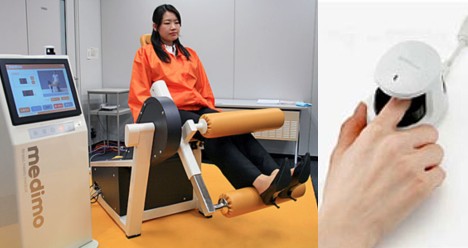

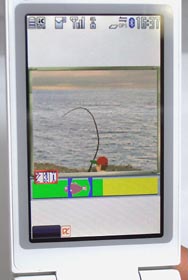 For mobile gamers in western Japan, a hearty seafood dinner awaits just a few key clicks away, thanks to a unique new cellphone fishing game that rewards successful players with home deliveries of fresh, real-world fish.
For mobile gamers in western Japan, a hearty seafood dinner awaits just a few key clicks away, thanks to a unique new cellphone fishing game that rewards successful players with home deliveries of fresh, real-world fish. 
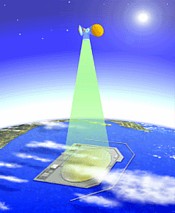 JAXA says the orbiting solar arrays, which have the advantage of being able to collect energy around the clock regardless of the weather on the ground, will need to transmit microwaves through the earth's atmosphere at frequencies that are not affected by the weather. The researchers are now looking at using the 2.45GHz and 5.8GHz bands, which have been allocated for use with industrial, scientific and medical devices.
JAXA says the orbiting solar arrays, which have the advantage of being able to collect energy around the clock regardless of the weather on the ground, will need to transmit microwaves through the earth's atmosphere at frequencies that are not affected by the weather. The researchers are now looking at using the 2.45GHz and 5.8GHz bands, which have been allocated for use with industrial, scientific and medical devices. 


 Whenever Robovie spotted people who looked disoriented, the child-sized droid wheeled up to them and asked, "Are you lost?" If so, the robot provided simple directions to the destination and pointed the way. If not, the robot proceeded to recommend nearby shops and restaurants.
Whenever Robovie spotted people who looked disoriented, the child-sized droid wheeled up to them and asked, "Are you lost?" If so, the robot provided simple directions to the destination and pointed the way. If not, the robot proceeded to recommend nearby shops and restaurants. 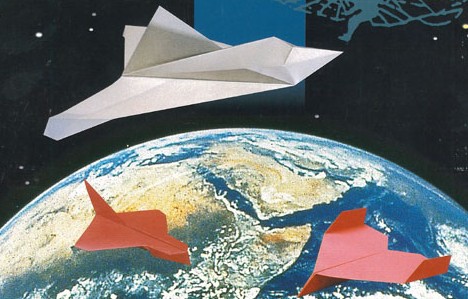
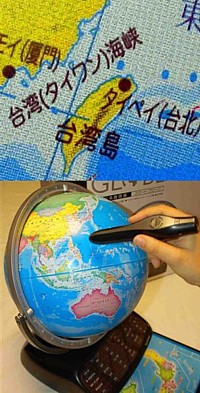 Tokyo-based educational company Gakken is recalling 10,000 of their electronic talking Smart Globes following a rash of customer complaints about a mislabeled Taiwan. On the globes, Taiwan -- a self-governing nation that split from communist China in 1949 during a civil war -- is labeled as "Taiwan Island," and the globe's smart pen reader, which streams audio data about a nation's geography, history and culture whenever you touch its location on the globe, identifies Taiwan as part of the People's Republic of China.
Tokyo-based educational company Gakken is recalling 10,000 of their electronic talking Smart Globes following a rash of customer complaints about a mislabeled Taiwan. On the globes, Taiwan -- a self-governing nation that split from communist China in 1949 during a civil war -- is labeled as "Taiwan Island," and the globe's smart pen reader, which streams audio data about a nation's geography, history and culture whenever you touch its location on the globe, identifies Taiwan as part of the People's Republic of China.  Ever wondered how much it would cost to build a working, life-sized
Ever wondered how much it would cost to build a working, life-sized  An IBM Blue Gene supercomputer would serve as the Gundam's computer system ($1.5 million sounds like a steal), and its movements would be driven by 30 giant 400KW motors -- 12 in the legs, 2 in the torso, 14 in the arms, and 2 in the neck. A 400KW motor is quite powerful -- by comparison, some Shinkansen bullet trains use 300KW motors. The motors alone would cost $7.8 million, but to power them would require the equivalent of 7 Apache helicopter engines (the helicopters cost an estimated $52 million each).
An IBM Blue Gene supercomputer would serve as the Gundam's computer system ($1.5 million sounds like a steal), and its movements would be driven by 30 giant 400KW motors -- 12 in the legs, 2 in the torso, 14 in the arms, and 2 in the neck. A 400KW motor is quite powerful -- by comparison, some Shinkansen bullet trains use 300KW motors. The motors alone would cost $7.8 million, but to power them would require the equivalent of 7 Apache helicopter engines (the helicopters cost an estimated $52 million each).